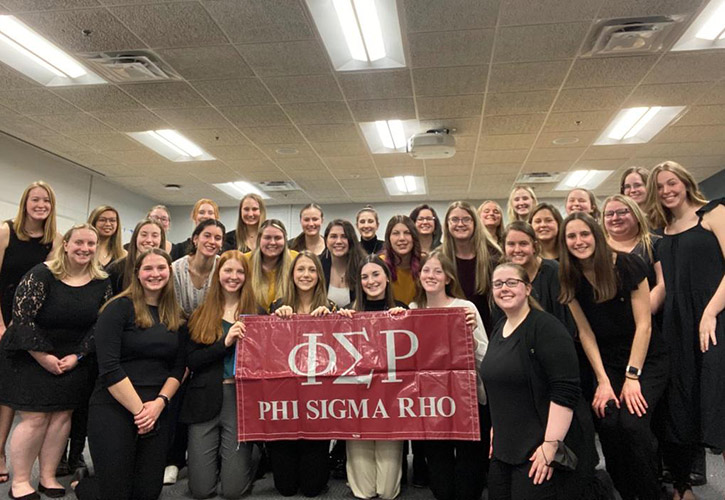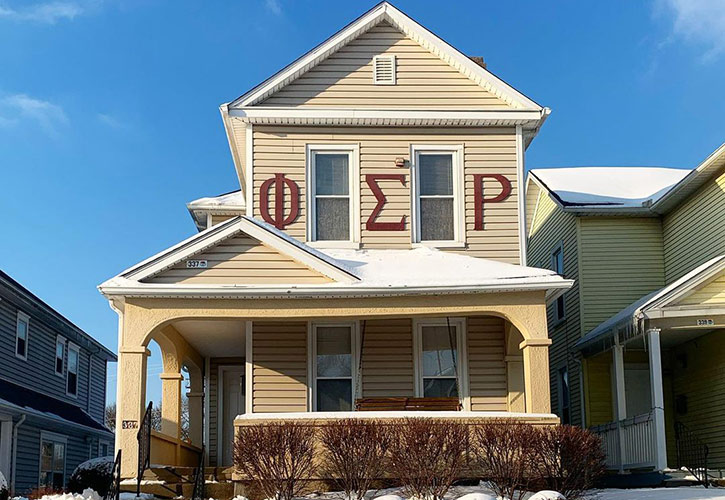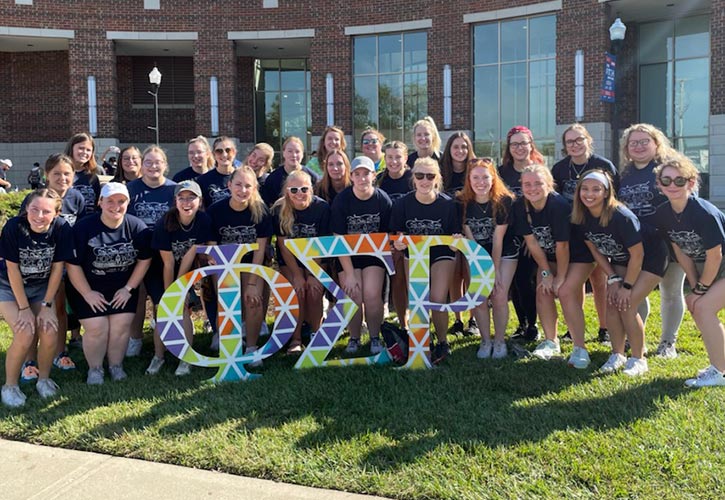Dayton Engineer

University of Dayton – Phi Sigma Rho Gamma Chapter – friendship, scholarship, encouragement
By Emma Kraft, School of Engineering Communications
In the words of Elana Chapman, University of Dayton alumna and founding member of the Phi Sigma Rho Gamma Chapter at the University of Dayton:
In 1988, Suzanne Baker called a meeting of women engineers to discuss the possibility of forming an engineering sorority. There were quite a number of women who met that night at Marycrest Hall dining room to discuss whether to form a new sorority (I recall that we had somehow already chosen the dolphin as our mascot), or join this one that Suzanne found called Phi Sigma Rho. From that group, and the vote we took, we started on the journey to join with Phi Sigma Rho and form a chapter at the University of Dayton.
Phi Sigma Rho UD History
It is clear now that we had to build relationships within the University and with the Phi Sigma Rho national organization. There were two groups that formed to pursue those two activities: Suzanne Baker, Penny Hogan, Mary Frecker and Christine Cleaves worked with the University deans and Greek Life for support. Suzanne Baker, Elana Chapman, Sue Razu and Christine Cleaves met with the Phi Sigma Rho Chapter at Purdue to determine the necessary steps to form the sorority.
As with any sorority or fraternity, the concern was the liability that it creates on the campus and to its members. But the founding group was committed to making their goal a reality. It took time to achieve the green light from the University and Greek Life, and during that time, we worked to determine what a sorority chapter needed to do and what Phi Sigma Rho national organization needed from us.
In 1989, we were initiated as a Colony and assigned a Colony Educator, Pam Kabbes. As Pam recalled to me, she really didn’t need to do anything to help us – just stand back and let us shine.
As I recall, our most pivotal event was preparing our Colony Proposal Petition to National Council. It was the first of its kind, and it has become the process for all of our new colonies to use. Many of us assisted in writing it, and we all signed the document.
In 1991, we presented that document to National Council at their Council meeting in Indianapolis and gained the acceptance to go from a Colony to a full Chapter.
We had a lot of fun organizing social, philanthropic, Greek Life and Chapter recruitment events. As we prepared for our recruitment events, we developed songs and skits in advance of the rush and recruitment time period. Singing songs at different events on campus brought great joy, and we left song books for the members that would follow.
We did get a house on campus for the Chapter, and it was my uncle, James Tiller, who cut and painted the letters for the house.
University of Dayton Gamma Chapter of Phi Sigma Rho
As a part of the School of Engineering, UD is proud to have the Gamma Chapter of Phi Sigma Rho on campus.
In 1984 at Purdue University, Phi Sigma Rho was the first social sorority for women in the engineering field. The sorority strives to uphold the vision of holding their members to a high standard of integrity and character, while helping one another achieve academic excellence and a strong bond of sisterhood.
The sorority builds upon three core values: Friendship, Scholarship and Encouragement.
Friendship
Women who join Phi Sigma Rho have the opportunity to create a strong network and social circle that lasts beyond their college years. The rituals of the sorority focus on the hearts and minds of their members to strengthen one another's lives.
Scholarship
The second value of Phi Sigma Rho, scholarship, is the foundation of the organization. Engineering is classified as an intense academic program, and, as a male-dominated field, can also be made difficult for women. The women of Phi Sigma Rho assist each other to overcome these struggles and to accomplish their academic goals.
Encouragement
Phi Sigma Rho is also associated with the School of Engineering Women Engineering Program at UD. WEP not only celebrates and encourages Phi Sigma Rho but also several other programs with similar values, such as Women in Science and Engineering and the Society of Women Engineers. All offer professional guidance and mentoring opportunities along with information and access to jobs and scholarships.
It is important to encourage one another, and Phi Sigma Rho constantly looks to provide an environment that both challenges and supports members.
Leukemia and Lymphoma Awareness Fundraiser
In addition to member benefits, Phi Sigma Rho raises money for Leukemia and Lymphoma awareness. In 2015, the sorority initiated the “Light the Night Walk.” And, the funds raised contribute to research, finding a cure and helping patients receive the treatment they need. The successful “Walk” has become an annual fundraiser for the UD Gamma Chapter.
Plus, the Gamma Chapter organizes events that directly affect the Dayton community. For example, they recently hosted a “Summer Pantry Cleanout,” where they encouraged others to donate any unopened dry or canned food and then donated the items to organizations, such as St. Vincent de Paul, the Women’s Shelter, and the House of Bread.
Alumni
To ensure close connections in friendships and professional development, Phi Sigma Rho maintains strong relationships with alumni. Annually, the national sorority holds a conference for chapters around the country. The conference provides opportunities for women to network and meet others with similar interests. Sisterhood events from alumni also include gift exchanges around the holidays and member accomplishment highlights in the Phi Sigma Rho newsletter.
To learn more about Phi Sigma Rho at the University of Dayton – Gamma Chapter, visit https://dayton.phisigmarho.org/ or contact gmmaphirho@gmail.com


